 Peacock Inachis io, Lardon Chase, Berkshire – Adrian Hoskins
Peacock Inachis io, Lardon Chase, Berkshire – Adrian Hoskins
Introduction
The Peacock is considered by many to be the most beautiful butterfly in the world. Its beauty was remarked upon as early as 1634 when Sir Theodore de Mayerne, physician to King Charles 1, noted that the ‘eyes’ on the wings of the Peacock butterfly “shine curiously like stars, and do cast about them sparks of the colours of the Rainbow”.
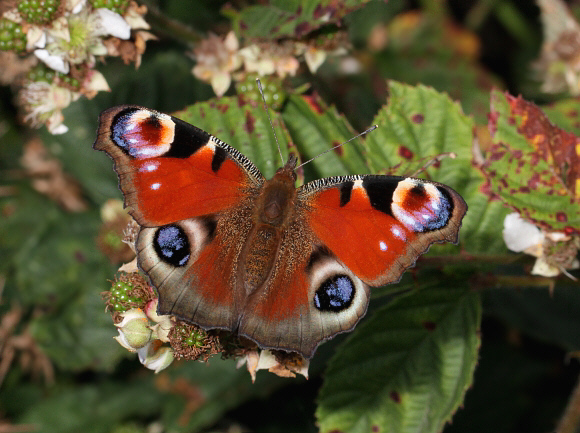 Peacock Inachis io, Alner’s Gorse, Dorset – Adrian Hoskins
Peacock Inachis io, Alner’s Gorse, Dorset – Adrian Hoskins
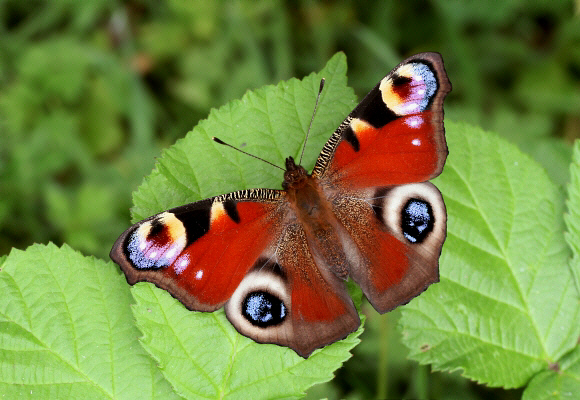 Peacock Inachis io, Hungerford, Berkshire – Adrian Hoskins
Peacock Inachis io, Hungerford, Berkshire – Adrian Hoskins
The butterfly is distributed throughout most of Europe but is absent from northern Scandinavia, and from most of southern Spain and Portugal. Beyond Europe its range extends across temperate Asia to Japan.
Habitats
In Britain the Peacock is a widespread and common resident, often seen in gardens, woodlands and flowery hillsides in late summer. The butterflies go into hibernation in September, over-wintering in hollow tree trunks, wood stacks, farm buildings, rabbit burrows and other locations where they can find shelter and darkness. In early spring they awaken and can often be often seen basking on bare earth on paths through woodland, along lightly wooded riverbanks, disused railway cuttings, old quarries and farmland.
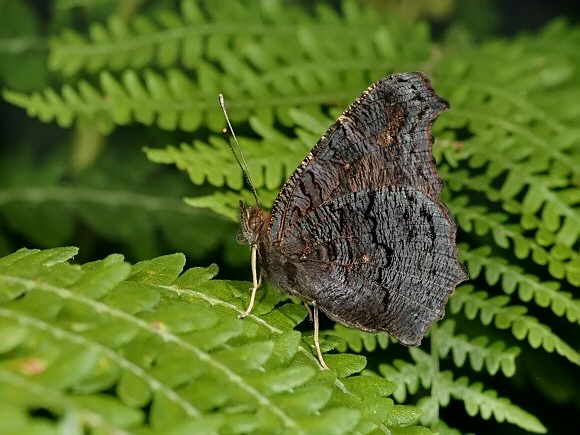 Peacock Inachis io, Alice Holt forest, Hampshire – Adrian Hoskins
Peacock Inachis io, Alice Holt forest, Hampshire – Adrian Hoskins
Lifecycle
In April and May, female Peacocks can often be seen flying around clumps of stinging nettle Urtica dioica in woodland glades, country lanes and farmland. They eventually settle under the upper leaves of the nettles, where they lay their dull green spherical eggs in large heaps.
Immediately after hatching, the larvae spin a silken web on the upper leaves of the nettles, and live within this during the early instars, venturing out to feed in warm weather. They all feed and grow at roughly the same rate.
After each moult they divide into increasingly smaller groups, each time moving on to another nearby plant. They are conspicuous, feeding openly in groups on the upper surface of the leaves. If molested they react by ‘reflex bleeding’, i.e. they spurt a foul smelling and noxious fluid from glands behind the head. This acts as a warning to wasps, spiders and predatory birds that they are distasteful and should be left alone.
Molestation also causes the caterpillars to wriggle violently and drop from their leaf into the herbage below, presumably as a defence against parasitoid wasps or flies. Nevertheless at least 90% of Peacock caterpillars fall victim to attack by the Tachinid fly Zenilla vulgaris. Other Tachinids including Pelatachina tibialis, Sturmia bella and Phryxe vulgaris are also recorded as parasitizing Inachis io.
By the time they reach the final instar the larvae become solitary in behaviour. They are handsome velvety black creatures, covered with black spikes, and studded with tiny white tubercles.
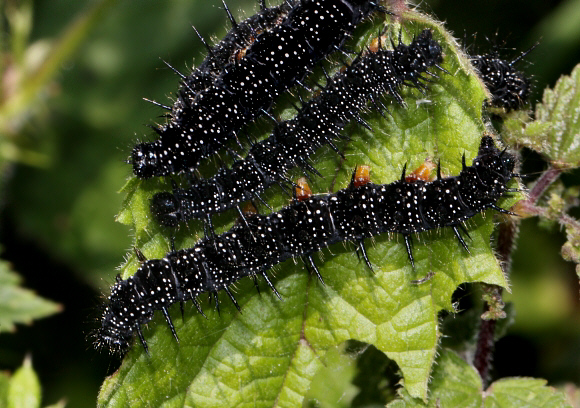 Inachis io, 5th instar larva, Hungerford, Berkshire – Adrian Hoskins
Inachis io, 5th instar larva, Hungerford, Berkshire – Adrian Hoskins
In some years Peacocks breed especially successfully and the larvae can be extremely abundant – on 5th July 2013 for example I checked a 400 metre stretch of hedgerow between 2 rape fields at Hungerford in Berkshire and counted no less than 22 separate larval webs comprising an estimated total of 1400 larvae, ranging from 1st to 4th instar.
The chrysalis is pale green with a dark diagonal streak across the wing cases, and can reputedly be found hanging from woody stems or tree trunks in the vicinity of nettles.
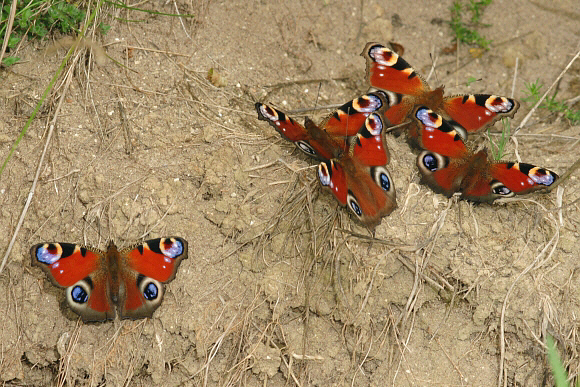 Peacocks Inachis io, Noar Hill, Hampshire – Adrian Hoskins
Peacocks Inachis io, Noar Hill, Hampshire – Adrian Hoskins
Adult behaviour
Peacocks emerge in late July and throughout August, and generally spend a few days very close to the emergence site, nectaring at thistles, knapweeds, hemp agrimony, ragwort, marjoram and bramble flowers.
At Noar Hill in Hampshire on 31st July 2009 there were an exceptional number of Peacocks present, well in excess of 150, by far the highest concentration of this species I have ever seen. There were often 15 or 20 on a small patch of thistle or a single clump of hemp agrimony. At about 6.30pm the breeze suddenly dropped, and cloud cover obscured the sun. The Peacocks quickly responded by settling in groups of up to 6 to bask on ant hills and patches of bare chalk.
After dispersing from the ‘honey pot’ nectaring areas in the countryside, the adults commonly visit gardens where they nectar at michaelmas daisies, ice plant and buddleia. In September they return once more to the countryside, visiting flowery hillsides where they gorge themselves on the nectar of devil’s bit scabious to prepare themselves for the long winter ahead.
By late September they enter hibernation, usually at woodland sites, where they spend the winter months hidden in hollow tree trunks, log piles, farm out-buildings and other cool dark places where their blackish mottled undersides provide them with excellent camouflage.
They re-awaken on the first sunny days of spring, sometimes as early as January, although mid March is more typical. They are very long lived butterflies, and there are usually a few individuals flying in late May or early June, almost overlapping with the next generation of adults.
 Peacock Inachis io, Noar Hill, Hampshire – Adrian Hoskins
Peacock Inachis io, Noar Hill, Hampshire – Adrian Hoskins
In spring Peacocks will use almost any available nectar source, including blackthorn, bugle, sallow catkins, bluebell, cuckoo flower, ground ivy, daisies, wood anemone and dandelion.
During April, at around midday, males establish small territories on the ground, typically choosing sunny sheltered spots close to hedgerows or woodland edges, or along woodland rides. Often as many as a dozen males will set up their territories close together along a woodland track, and each will instantly fly up to chase after any passing bee, fly or butterfly.
In April 2006 I watched 2 males that had set up territories about 5 metres apart, along a ride in Stansted Forest. One male had been chasing after a Comma, and encroached into the territory of the other male Peacock. A sortie then took place, with both males spiralling rapidly to a height of about 20 metres before separating and returning to their original territories.
On another occasion I watched a male Comma defending its territory against a Peacock. Despite the greater size of the Peacock, which repeatedly attempted to occupy the territory, it was successfully ousted by the Comma.
In April 2007 at Botley Wood I watched a sortie between a male Comma and a male Peacock both of who believed they had ‘ownership’ of a particular birch log. The pair engaged in battle dozens of times during a 20 minute period but eventually the Peacock was driven off, leaving the Comma to occupy the territory.
When female Peacocks pass through the male territories they are instantly intercepted and pursued at high speed. Often the chasing male will inadvertently fly into the dominion of another male, and a territorial battle will take place during which the female will escape. Despite the abundance of the butterfly, neither myself, or as far as I am aware anyone else, has observed the courtship or found a copulated pair.
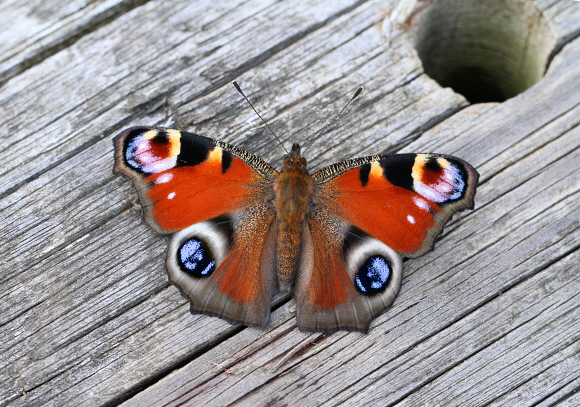 Peacock Inachis io, Hungerford, Berkshire – Adrian Hoskins
Peacock Inachis io, Hungerford, Berkshire – Adrian Hoskins
Peacocks often close their wings when settled, but if disturbed suddenly re-open them, producing a rasping or hissing sound created by rubbing the veins on the forewings and hindwings together. The sudden appearance of the ‘peacock eyes’ probably functions to startle attacking birds. The effect is short-lived however and having recovered its senses the bird may still attack.
The ‘eyes’ then serve to divert the attack away from the butterfly’s vulnerable body and onto the outer part of the wings. Butterflies are usually still able to fly well, even with large chunks pecked out of their wings. It is thought that the hissing noise is a defence against bats which may disturb the butterflies when they enter caves or hollow tree trunks to roost or hibernate.
In a study by Stockholm University, the ocelli of several Peacocks were blanked out with a marker pen. When exposed to blue tits, 13 out of 20 were attacked and eaten. A control group of Peacocks with the ocelli intact fared much better, with only a single butterfly attacked out of a group of 34.
It can be concluded that in 97% of encounters with blue tits, the ocelli are effective as a deterrent, and the butterfly will escape unharmed. A project carried out by another biologist found that normally marked Peacocks escaped attacks by yellow buntings 76% more often than Peacocks that had their eyespots painted out.
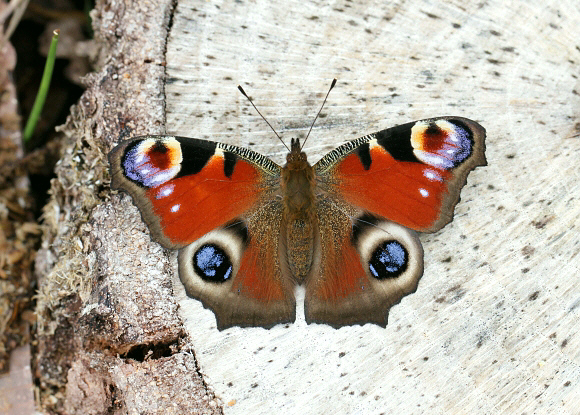 Peacock Inachis io, Alner’s Gorse, Dorset – Adrian Hoskins
Peacock Inachis io, Alner’s Gorse, Dorset – Adrian Hoskins
